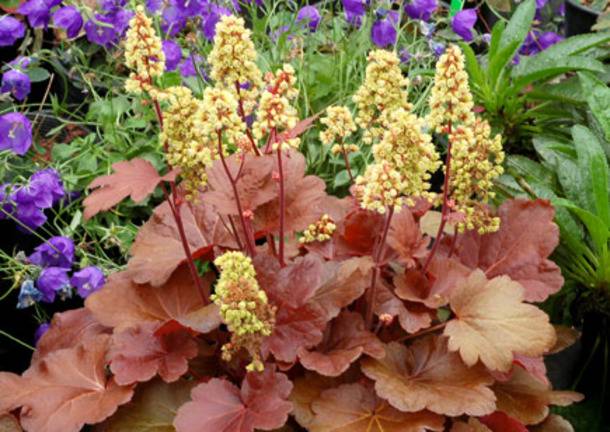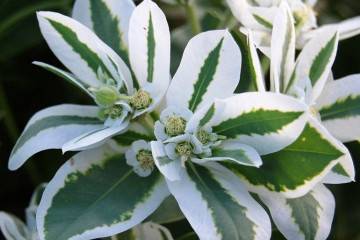Heuchera Rio: description
Content:
Geuhera Rio is known for having a variety of incredible leaf colors. However, only minor care is required for it. Due to its decorative qualities, this plant is rapidly gaining popularity in the design of compositions in landscape design. To use it correctly, you need to know more about this wonderful plant.
Heuchera Hybrida Rio
This plant is a herbaceous perennial. Geichera belongs to the genus Saxifrage. The name of the plant comes from the surname of the German scientist G. von Heicher. In the wild, this shrub grows in North America on mountain slopes. The plant attracts attention with beautiful and varied decorative coloring of the leaves.
For a long time, Heuchera Rio was not popular, but recently it has been actively used in landscape design. There are no difficulties in growing this crop. Properly carried out care will allow you to enjoy the view of this ornamental shrub throughout the spring-autumn period before the onset of winter cold. Heuchera Rio grows up to 50 cm in height.
1 g can contain up to 20 thousand seeds.
Application ideas in landscape design
The work of breeders led to the fact that new beautiful varieties of Heuchera were bred. Therefore, such a shrub takes up more and more space in the ideas of landscape designers.
This plant has found its application in the following cases:
- Heuchera looks beautiful if it is used in mixborders. In this case, not only flower, but also shrub compositions can be used;
- the shrub goes well with roses, hosta, irises and daylilies as their companion;
- the use of heuchera emphasizes the beauty of early bulbous flowers. This is due to the fact that in early spring, the bush retains basal deciduous rosettes;
- when creating rock gardens and rockeries, heuchera looks organic;
- varieties that have beautiful inflorescences can be used as cuttings;
- this shrub can be grown as a container plant;
- Heuchera looks beautiful when it grows next to a pond.
Flower garden propagation methods
Seeds planted in open ground, seedlings grown independently, cuttings, dividing the root system of a bush can be used for reproduction.
Seed use
Reproduction of Heuchera Rio, according to the description, can occur with the help of seeds from which seedlings are grown. They remain viable for a year and a half.
When receiving seedlings, there is no need to carry out stratification. The time for landing in open ground begins in mid-March.
For growing seedlings, plastic containers with a depth of at least 5 cm are suitable.Holes must be drilled in the lower part to allow excess water to drain out.
It is necessary to decontaminate the ground before planting. This can be done by saturating the soil with a fungicide or a weak solution of potassium permanganate. After the ground dries out, you can plant plants in it.
The seeds of this shrub are very small. Before placing in plastic containers, you must mix them with sand. After that, the mixture is carefully scattered over the surface of the soil. It is not required to deepen the seeds. Then the container is covered with glass or foil on top and placed in a warm place. It is necessary to provide a temperature of 20-22 ° C, high-quality lighting, protect the planting from drafts or strong winds.
When mid-May comes, you need to start hardening. To do this, glass is removed every day for a while, the seedlings are taken out into the street. Gradually, the time of this procedure is increased.
Dividing the bush
The division of the bush is carried out after he turns three years old. It is convenient to do this when transplanting in spring or autumn. You need to dig out the root and divide it with a sharp knife into several parts. Each must have at least 2-3 sockets. The incision sites must be protected from infection by treating with root or ash. Then the delenki need to be transplanted to a new place. They take root in two months.
Cuttings
To obtain planting material, you need to cut off a part of the lateral shoot with a piece of the root rosette. The cut is treated with root root so as not to infect. The planting material is planted in holes and covered with foil. It is necessary to provide the cuttings with watering and warmth. Regular ventilation is required. Within a month, the cutting should take root.
Landing in open ground
Heuchera can be planted in open ground, provided that warm weather has already established and the ground has warmed up well. It is recommended to dig up the soil before planting to loosen the soil. In this case, it will be useful to add a little sand to the soil.
For seedlings, pits are pre-dug in which the root system can easily fit. The interval between plants should be at least 20-25 cm. A drainage layer is poured at the bottom, for which you can use small stones or pebbles.
Since Heuchera is a Hibrida variety, it must be borne in mind that when propagating by seeds, you cannot use those obtained from your own plants. They do not preserve the properties of the parent hives. For the propagation of hybrid varieties, it is necessary to purchase seed in specialized nurseries.
Planting can be done in March, April or May. It is allowed to do this in the fall, but on condition that the heuchera will have time to take root before the winter cold sets in.
Site selection
When choosing a site for growing, you need to remember that places that are slightly shaded are better suited for this plant. Geikhere will be good on the western or eastern side of the site next to the spreading trees.
A neutral or slightly acidic soil is suitable for the plant. The pH value should not be more than 6. It is undesirable to plant Heuchera in low and swampy areas. This can lead to waterlogging and root rot.
Fertilizing and fertilizing plants
Geyhera care is not difficult. In this case, it is advisable to follow the existing rules for growing a plant.
Shrub roots are located close to the surface. Therefore mulching is important. If you cover the surface with sawdust, straw or dry leaves, it will help to retain moisture longer, and protect Heuchera from weeds and pests. In addition, after watering and drying the soil, a hard crust will not form on the surface.
In nature, Heuchera, due to its characteristics, is able to grow on nutrient-poor soil. Therefore, in most cases, you can do without feeding. However, when it comes to ornamental varieties, then in this case, fertilization will allow you to get fast foliage growth and picturesque colors of the leaves of the shrub. In this case, complex fertilizers are applied in early spring. In this case, it is necessary to reduce the concentration of dressings in comparison with the usual two times.
Watering
During the period of active growth, it is necessary to ensure regular watering. If the soil dries up, it means that it is time for the next irrigation. If the plant begins to lose moisture, the leaves of the bush will be lethargic and ugly.
In hot weather, in the absence of rain, watering should be done every two days. In this case, it is worth not allowing waterlogging.
Water must be poured at the root and pay attention to the fact that it does not fall on the leaves. Droplets on greenery can be burned in direct sunlight.
Bloom
Heuchera begins to bloom at the beginning of summer. Flowers can be seen on the shrub during the entire summer-autumn period. It will end when the winter cold is about to set in.
How to transplant Heuchera in the fall to another place
This plant can be transplanted in spring or autumn. This is done in the event that he needs a new soil. This can happen if the soil has become insufficiently fertile or the roots of the plant have begun to rot or have been infected with fungi. In the first case, it is recommended to transplant together with a lump of earth, in the second, freeing the Heuchera from the ground.
The first option is less traumatic. In a new place, you need to dig a hole in which the root system will completely fit. At the bottom you need to pour a layer of drainage and add humus.
There is no need to spend a lot of effort to grow this shrub. Geichera has found its application in landscape design due to the unusual beauty of its leaves and undemanding care.






















